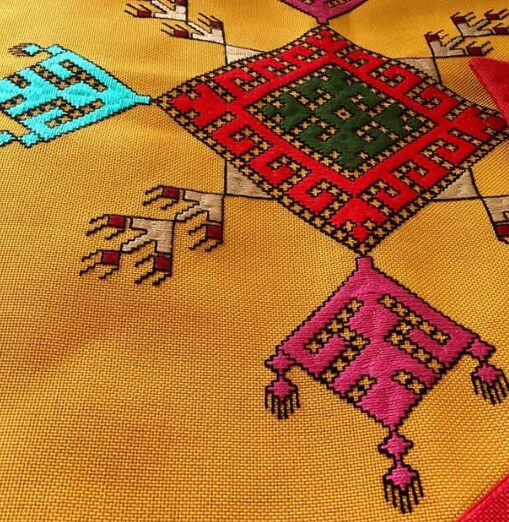The needlework of Sistan and Baluchistan, Iran, is a vibrant and diverse tapestry of traditions and techniques, bursting with color, symbolism, and intricate craftsmanship. Here’s a glimpse into this captivating world:
A Spectrum of Styles:
Suchan Duzi: The most prevalent style in Baluchistan, featuring bold geometric patterns, animal motifs, and floral details. Often uses vibrant colors and silk thread for a striking visual impact.
Sistan Embroidery: Known for its geometric and linear designs, often in black and white or contrasting shades. Features motifs like squares, triangles, and diamonds, with a focus on clean lines and symmetry.
Cream Embroidery: A more subtle style, primarily using shades of white and beige. Features delicate geometric and floral patterns, often embroidered with silk thread for a touch of elegance.
Dodni Weaving:A unique technique of weaving two layers of fabric simultaneously, creating intricate patterns and textures. Often features vibrant colors and geometric motifs.
Coin Embroidery:A blend of artistry and practicality, incorporating old silver or copper coins as embellishments. Creates shimmering metallic patterns and showcases the creativity and resourcefulness of Baluchi women.
Cultural Significance:
Symbol of identity and heritage:Each embroidery style reflects unique aspects of Baluchi culture and traditions, passed down through generations.
Adornment and status: Needlework was traditionally used to decorate garments, particularly for special occasions like weddings and festivals. Elaborate designs often signified wealth and social standing.
Economic empowerment:Needlework provides income for many Baluchi women, particularly in rural areas. Preserving these traditions supports local livelihoods and cultural sustainability.
Challenges and Preservation:Modernization and changing tastes: Competition from modern styles and readily available materials poses challenges for traditional needlework.
Limited market reach: Artisans often struggle to reach wider markets and achieve fair compensation for their work.
Documentation and training: Ensuring the transmission of traditional skills and designs to future generations is crucial for the survival of these art forms.
Supporting and Appreciating:Visit museums and exhibitions: Museums in Iran like the National Museum of Iran showcase stunning examples of Baluchi needlework.
Support artisan communities:Purchase needlework pieces directly from artisans or through reputable online platforms that promote fair trade practices.
Raise awareness:Share information and stories about Baluchi needlework to increase public appreciation and understanding of this rich cultural heritage.
By appreciating the diversity, symbolism, and cultural significance of the needlework of Sistan and Baluchistan, we can help preserve this vibrant tradition for future generations. Remember, every stitch tells a story, and every motif represents a piece of this region’s unique cultural tapestry.


